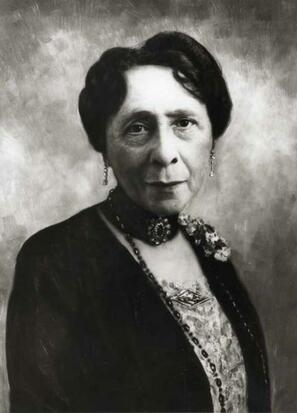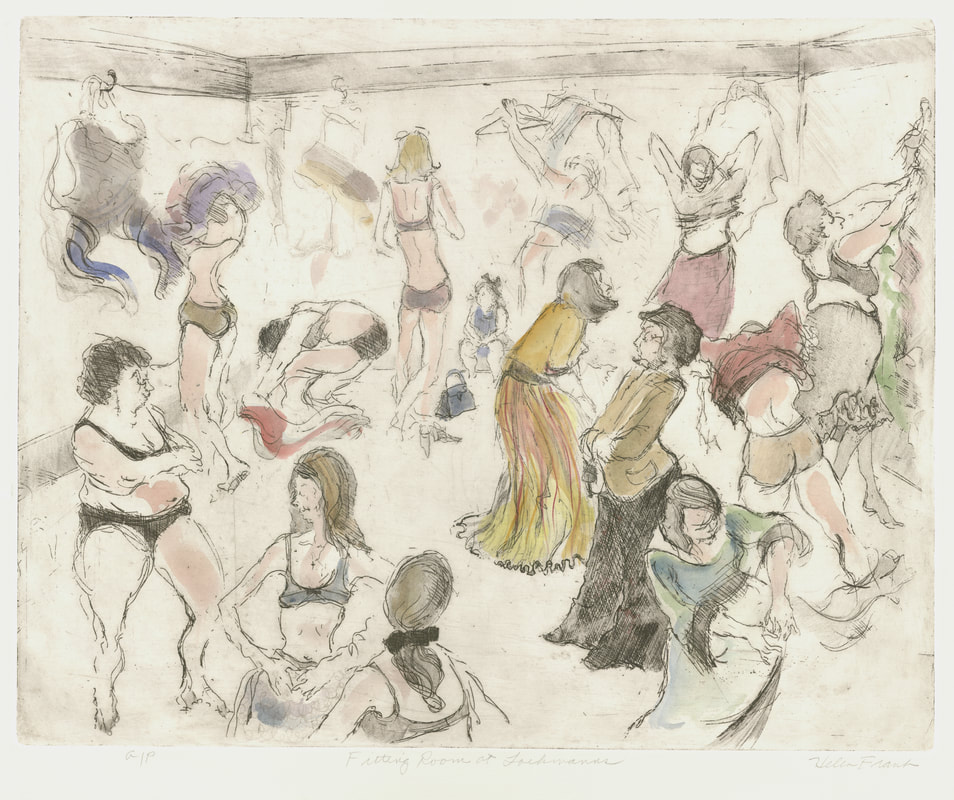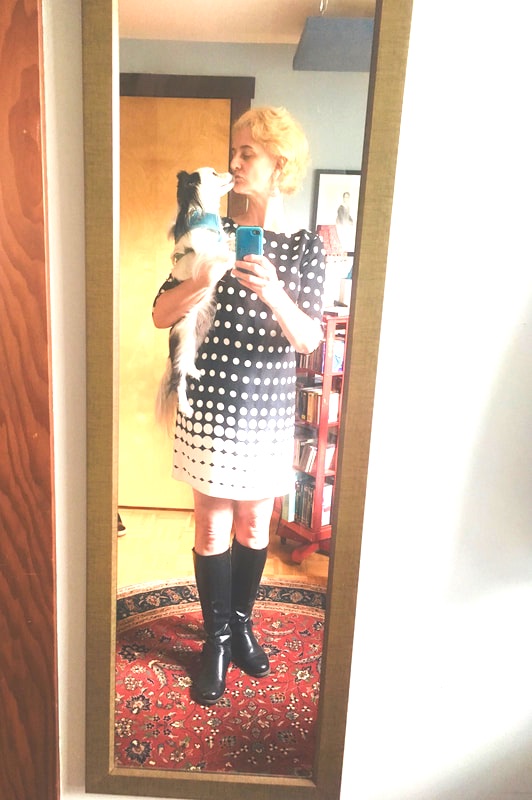 Maryann Magnin, photo used with permission from the American Jewish Historical Society
Maryann Magnin, photo used with permission from the American Jewish Historical Society For Carol
Travel with me back in time. It’s 1976. A Saturday morning, early. I’m in the back seat of a Ford Country Squire Station Wagon that has a wood-paneled exterior and more steel than a fleet of Priuses. Mom is at the wheel. Riding shotgun is my older sister. At sixteen, she is the most glamorous person I know. I’m in the backseat, leaning forward so I can arrive just a split second sooner.
We’re going to the City. Better than that, we’re going to Magnin’s.
To say that I. Magnin and Company represents old California would be an understatement. In 1876 Dutch-born Maryann Magnin, the daughter of a rabbi, immigrated to Oakland and began selling high-end baby clothes. The “I” was for Isaac, her husband. As the business expanded, the locations improved. The building we’re headed to is on Union Square. Ten stories of white marble built in 1948, a time when the department store stood as a gleaming palace on the hill of the American psyche, a repository for postwar plenty and a conduit for the magic of modernity. It was a time when families all over the country loaded themselves into big cars like ours and sailed downtown to buy a belt, a sofa, or a set of tools. For people in the Bay Area, it was Sears. The Emporium. Capwell’s. Bullock’s.
For the women of my family, the biannual sales at I. Magnin’s were a pilgrimage of the highest order, for the lowest prices. A time to claim our rightful inheritances as Queens of Frugality. Unlike today, when this season’s clothes disappear magically from store shelves, making their way to secondary retail houses like Ross, or TJ Maxx, in those days many stores cleared their own inventory, creating deep-cut annual sales like the one at Magnin’s, or places like Capwell’s Basement, with its large tables piled high in pants, bras, dresses. Tables you could stand at for hours, moving your arms through the clothing like a gold miner, elbow-deep in the river, searching for treasure.
Arriving in the City for the Magnin’s sale, we thread the long body of the Country Squire around the tight spiral ramps of the newly expanded parking garage at Sutter and Stockton, and then walk through Union Square, heads held high as we march right past Macy’s (and it’s full retail prices.)
Arriving at Magnin’s, we grasp the ornate brass door handles, still cold to the touch from the San Francisco fog, and step inside, immediately enveloped by a sense of richness. The large, two-story room glows from Lalique light fixtures hanging in a golden ceiling. Powdery floral breezes waft over towards us from the cosmetics in the Mural Room with its stained glass by French artist Max Ingrand,whose work can be seen in other obscure places, like Notre Dame. Not to be distracted, we head straight to the elevators, Mom setting a fast pace as if leading us into battle, and up we go, our stomachs doing a little flip as we ascend, anticipating the glorious things we will find.
I am about to sound like an old lady, but I don’t think I own one piece of clothing today that is as well-made as the things we used to buy at Magnin’s. Wool skirts with real linings, pants and shirts that lasted for years, and years. And the prices were astonishing, so we bought plenty. Walking back to the car, our arms grow longer from carrying heavy bags, and again we walk quickly, like bank robbers, hurrying from the scene of the crime.
Loehmann’s was another Mecca for us. In 1921, Frieda Loehmann put her knowledge as a department store buyer to use, acquiring the season’s designer overstock for a pittance and selling it at a bargain. The idea took off and Loehmann’s became a chain. (And a concept, later copied by many.) Mom had grown up going to Loehmann’s in New York, so when my sister and I went with her and Grandma, it was a tradition continued, a touch of old New York right there in the East Bay. One time I snapped a picture as Mom and Grandma walked in. I wanted to capture that moment, their backs slightly hunched as they lurched forward, purses clasped tightly under their arms. I felt I was witnessing a vestige of ghetto life, a time when Jews had to be savvy, to scrounge and forage to survive. There’s nothing to match the focus and intensity of mothers and daughters on a trip to Loehmann’s. When I was sixteen I read Lauren Bacall’s autobiography, and she described just such a scene with her mother at the original Loehmann’s, in a former auto showroom in Brooklyn. And that’s how I felt. When I went to Loehmann’s, I was connected to a great lineage of women in pursuit of fashion. I was a New Yorker. I was Lauren Bacall.
Loehmann’s had much to recommend it, with its tantalizing, slightly illicit-sounding “Back Room” for designer fashion. But my favorite thing about Loehmann’s was the communal dressing room. Mirrors all around, no limit to the number of items you could bring in, beyond what you could manage to carry in your arms. Everybody half-naked, and free to comment on anything they liked. “You’re not getting that? I’ll try it!” someone would say, grabbing my reject from the rack in the middle of the large space. “What a figure!” the old lady next to mom might say, pointing to me, and I would blush as the other women nodded, feeling like I had a dozen kind grandmas. I’m not alone. Loehmann’s dressing room is immortalized in an etching with hand coloring by artist Helen Frank. And Erma Bombeck, a humorist I used to think was corny, but now seems increasingly wise, once titled one of her books, “All I Learned About Animal Behavior I Learned in Loehmann’s Dressing Room.”
Of course, shopping wasn’t just about clothes. On most every Saturday morning my siblings and I woke to the blaring horn of the station wagon, signaling us to get out of bed and come unload the haul of goods (and not-so-goods) mom had acquired in her garage sale-ing. But sometimes Mom paid full price. When Mom and Dad had a party, we always made a trip to the Genoa delicatessen in Oakland, back when it was a postage stamp-sized shop where we would crowd in shoulder-to-shoulder and pick a number. Mom would buy sliced salami, and ravioli.
For Dad, a love of shopping was all about books. Once, during the turbulent sixties, Dad was browsing at a bookstore on Telegraph Avenue while the rest of us were waiting in the car. Mom, me, my brother, and my sister. Waiting. And waiting. It was one of those times as a kid when life gets very vivid all of a sudden. Mom was fuming. I could almost see the steam coming out of her ears. Suddenly there was a huge crash above us. Someone had thrown a gigantic pumpkin from an apartment above, and it landed square on the roof of our car. Perhaps our station wagon was a symbol of the bourgeoiserie, and they were making a statement. Perhaps they were on LSD, and thought the pumpkin was a bomb that needed to be gotten rid of. Either way it was the last straw for Mom. With three frightened children, the wet flesh of the pumpkin-goo pouring down the windows around us, she ordered my big sister to go in and get Dad, which she did, dragging him away from the books like an alcoholic from the bar.
Telegraph Avenue is different these days. The flagship of revolutionary cafés, Café Mediterranean, also known as “the Med”, is recently closed. Meanwhile, the Genoa has one location left, not the original. Loehmann’s went bankrupt. I didn’t know it at the time, but even before they moved into the “White Marble Palace”, as Christian Dior called it, I. Magnin’s had been sold to the Bullock’s chain, and by the time I was shopping there the two had merged to become “Federated Department Stores.” Later the Magnin’s and Bullock’s brands were bought out by Macy’s, before disappearing entirely after a “realignment.” Until recently, though, one could still use the sixth floor restroom. Made of green marble, fit for royalty, it had become part of Macy’s. But the building recently changed hands again, so that, too, is ended.
And so it goes.
These days my shopping patterns are varied. I have my favorite local shops, many of which seem to close too soon, but I’ll admit to ordering frequently online, and shopping at large discount stores. I’d like to say that every time I do, I wonder what beloved local business I am helping to kill, but I don’t. That would be too exhausting. Mostly, I appreciate the time and money saved.
Still, I think about it. Where that bookstore on Telegraph stood, just a few doors down from the old Café Med, is a gleaming new café. It has tall windows and stark black tables that no one will ever carve their names into, and around which no revolutions will be planned. I drive by one evening and see the students, each illuminated in the solitary glow of their laptops. I feel the urge to stop. To go in and tell them that this once was a bookstore, and that someone smashed a pumpkin on the roof of our car. I want to tell them about Loehmann’s, and Magnin’s, and the Genoa, too. I want to ask them, and myself, and all of us, what are we doing?
Fortunately, Magnin’s lives on in other ways. The company grew deep roots in California, and San Francisco in particular. Joseph, one of Maryann and Isaac’s eight children, founded his own clothing company, which was run by his son, Cyril Magnin, and Cyril’s philanthropy is legendary in the City. He helped to establish the Asian Art Museum, American Conservatory Theater, and was a staunch supporter of the opera and other artistic institutions, earning him the moniker “Mr. San Francisco” from none other than Herb Caen, the beloved columnist who would’ve been well within his rights to claim the title for himself.
You can never go home again, so they say. But I miss Herb Caen. And I miss those sales at Magnin’s. The rest of the year Magnin’s belonged to socialites and wealth-mongers, the crème de la crème. But twice a year, it was ours.
It’s hard to put your finger on what’s missing from shopping these days. But I guess for me it’s the ride home. Mom is at the wheel. My sister still gets the front seat, and I’m in the back. But now I’m not leaning forward. I’m resting deeply into that giant Country Squire seat, lightheaded, and exhausted, surrounded by bags. Classy bags made of thick, stiff paper, with silk rope handles and embossed lettering that reads, “I. Magnin and Co.”
P.S. In researching this article, I found my way to various I. Magnin images and memorabilia, one of which was the dress below, which I bought on Ebay. What a steal!
*Helen Frank print used by permission of Lafayette College, Helen Frank Master Print Collection, 1949-2014. Special Collections & College Archives, David Bishop Skillman Library, Lafayette College. Special thanks to Elaine Stober, college archivist, and also to Melanie Meyers, Director of Collections at the American Jewish Historical Society for allowing the use of the picture of Mrs. Magnin.


 RSS Feed
RSS Feed